.
22.07.2015
Mystery haze appears above Ceres' bright spots
Discovery bolsters idea that intriguing marks are made of ice, not salt.
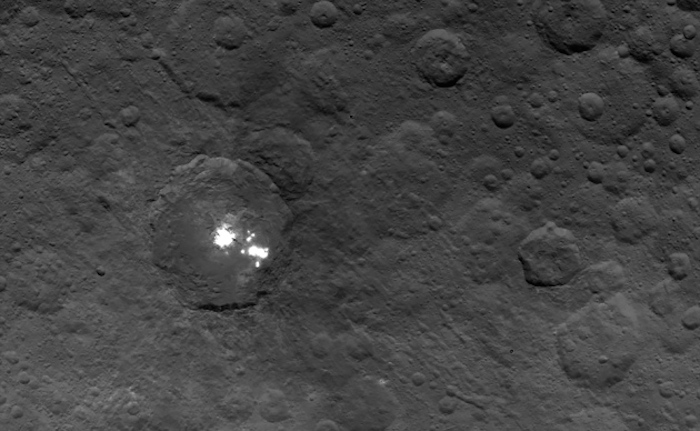
Bright spots in Ceres' Occator crater have intrigued scientists for months.
Ceres, the biggest asteroid in the Solar System, has a haze that appears occasionally in a crater above some of its mysterious white spots.
The phenomenon, observed by NASA's Dawn spacecraft, suggests that the bright spots “could be providing some atmosphere in this particular region of Ceres”, says Christopher Russell, a planetary scientist at the University of California, Los Angeles.
Dawn has been orbiting Ceres since March. Russell, the mission’s principal investigator, described its initial findings at a NASA exploration meeting at the Ames Research Center in Moffett Field, California, on 21 July.
Haze on Ceres would be the first ever observed directly in the asteroid belt. In 2014, researchers using the European Space Agency's Herschel Space Observatory reported seeing water vapour spraying off Ceres, which suggested that it was a geologically active world1. Ceres is made of at least one-quarter water, a far greater proportion than seen in most asteroids.
Bright spots pepper Ceres’ surface, but the haze has been seen in only one location so far — a crater named Occator, which has a large bright area at its centre and a bunch of smaller spots nearby. Mission scientists have been trying to figure out whether the bright spots are made of ice, evaporated salts or other minerals, or something else entirely.
Some team members had been leaning towards the salt explanation, but the discovery of haze suggests the presence of sublimating ice. “At noontime, if you look at a glancing angle, you can see what seems to be haze,” Russell says. “It comes back in a regular pattern.” The haze covers about half of the crater and stops at the rim.
.
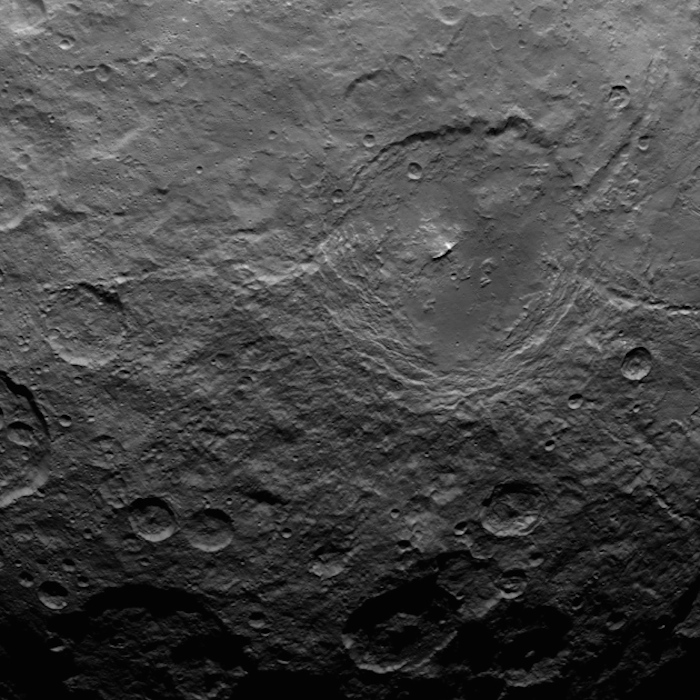
Ceres' surface is pockmarked by craters and the occasional mysterious patch of highly reflective material.
Eyes on the prize
The Dawn spacecraft carries an infrared spectrometer that should be able to discriminate easily between ice or salt. But that instrument, which is mapping Ceres' surface, has not had a chance to study the spots properly yet. It has been out of commission for small periods of time, leaving blank spots in the map, Russell says. The same spectrometer experienced problems back when Dawn was orbiting a different asteroid, Vesta, in 2011-12.
Dawn has also found that Ceres is slightly smaller than expected, making it roughly 4% more dense than scientists had thought, Russell reports. And the obliquity, or tilt, of its orbit is the reverse of what scientists had anticipated: “Summer is winter and winter is summer,” he says.
Ceres' striking 5-kilometre-high mountain, informally dubbed ”the pyramid”, may be similar to the mountains seen last week on Pluto by the New Horizons spacecraft, Russell adds.
At nearly 1,000 kilometres across, Ceres is designated as a dwarf planet, and understanding it could help scientists better understand the relationship among all the objects in the Solar System. ”Ceres is so big compared to all the other asteroids that it's really different,” says Andrew Rivkin, a planetary scientist at the Johns Hopkins University Applied Physics Laboratory in Laurel, Maryland. “It's sort of the penultimate step before a planet.”
Following a brief interruption in normal operations on 30 June, Dawn is now once again spiraling closer to Ceres. It is less than 4,000 kilometres above the asteroid's surface, aiming for less than 1,500 kilometres by next month.
Quelle: nature
-
Update: 28.07.2015
.
Dunst als Geheimnis der hellen Flecken auf Ceres erkannt
The intriguing bright spots on dwarf planet/asteroid Ceres have been fascinating the public and scientists alike for the past few months, and now a new discovery might provide a valuable clue as to just what these spots are made of: The Dawn spacecraft has detected a periodic haze over the brightest spots in Occator crater.
The haze reportedly can be seen in the crater at certain times of the day and has been seen more than once now. It also appears to be confined to within the crater itself.
Christopher Russell, a planetary scientist at the University of California, Los Angeles, suggests that these bright spots “could be providing some atmosphere in this particular region of Ceres.” He added: “At noontime, if you look at a glancing angle, you can see what seems to be haze. It comes back in a regular pattern.” The haze appears to cover about half the crater and stops at the rim.
.
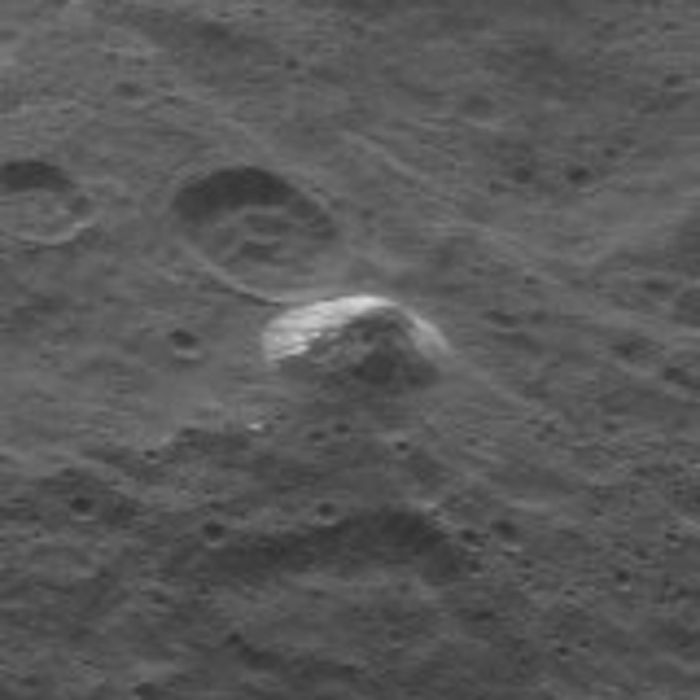
Close-up view of the odd conical mountain on Ceres, which is thought to be composed of solid ice. Photo Credit: NASA/JPL-Caltech/UCLA/MPS/DLR/IDA
.
This is the first time that haze has been reported on any object in the asteroid belt. It was already known that there was water vapor on Ceres, thanks to the Herschel Space Observatory, which detected it in 2014. Whether this haze is actually water vapor isn’t known yet, but it seems to be a good possibility given the previous findings.
It also isn’t known yet what the spots themselves are composed of, but mission scientists have been leaning toward ice or salts as the two most likely explanations. Ice may sublimate into vapor, which could account for the haze. Also, if the spots are evaporated salts (or ice), they could be leftover deposits from active cryovolcanism, a form of volcanism involving water and ice instead of molten rock. Ceres’ mass is already known to be composed of at least one-quarter water, more than any other known asteroid, so it’s an intriguing possibility. Ceres may turn out to be more geologically active than anticipated.
Adding to the puzzle, Russell had also tweeted: “Ceres bright spots have unusual distribution. Not created by impact. Different sizes, famous one is most complex set.”
At almost 621 miles (1,000 kilometers) in diameter, Ceres isn’t all that big by planetary standards, but is a good size for a dwarf planet or asteroid. “Ceres is so big compared to all the other asteroids that it’s really different,” said Andrew Rivkin, a planetary scientist at the Johns Hopkins University Applied Physics Laboratory in Laurel, Md. “It’s sort of the penultimate step before a planet.”
Dawn is just now entering a lower orbit around Ceres, which will provide closer images of these bright spots. Spots of various sizes and brightness have been seen all over Ceres, but the brightest ones in Occator crater (known collectively as Spot 5) are the ones that first grabbed attention. An infrared spectrometer onboard the spacecraft will help to determine if the spots are made of ice, salts, or something else. The first images have been tantalizing, but there is still debate as to how big these spots are and whether or not they are elevated above the surface. Interestingly, the first distant images seemed to show one bright spot, then two as the resolution increased, and now they are seen as two primary bright posts with numerous smaller ones around them.
There is also a fascinating conical mountain elsewhere on Ceres, which is about 3 miles (5 kilometers) tall, which is thought to be composed of solid ice, similar to the newly found mountains on Pluto. This mountain, though, is solitary, standing alone on an otherwise relatively flat plain.
.
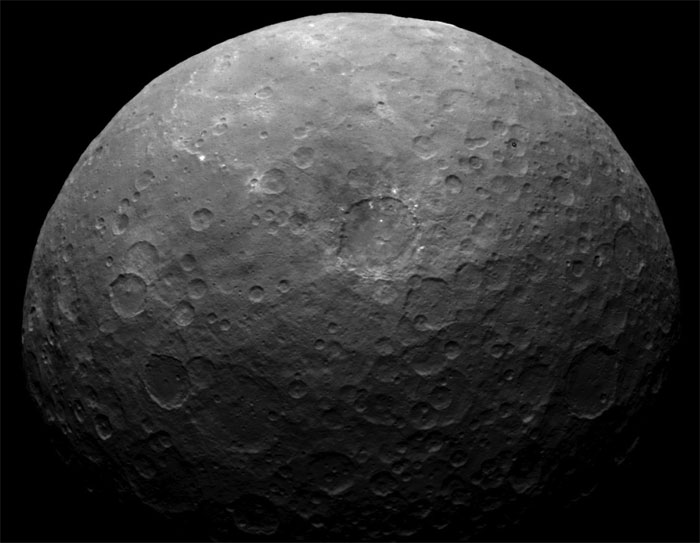
There are numerous bright spots on Ceres, but none are as prominent as the ones in Occator crater, where the haze was detected. Photo Credit: NASA/JPL-Caltech/UCLA/MPS/DLR/IDA
-
Dawn also found that Ceres’ axial tilt is the opposite of what had been expected. As Russell noted, “Summer is winter and winter is summer.”
Right now, Dawn is orbiting less than 2,485 miles (4,000 kilometers) above Ceres’ surface, and by August it will be less than 932 miles (1,500 kilometers). From that vantage point, it will have the best view yet of the spots and haze, the biggest surprises of the mission so far. Whether Ceres is still geologically active or not, the study of this small world will be a major step in the understanding of other dwarf planets and asteroids. Some apparent shared characteristics with other bodies such as Pluto should help planetary scientists better understand the history of these fascinating worlds and how they evolved throughout the history of the Solar System.
Ceres’ surface is battered with many craters, but the puzzling features seen like the spots, haze, and weird mountain suggest that this small, enigmatic world may still be a geologically active place after all.
Quelle: AS
-
New Names and Insights at Ceres

This color-coded map from NASA's Dawn mission shows the highs and lows of topography on the surface of dwarf planet Ceres.
.
Colorful new maps of Ceres, based on data from NASA's Dawn spacecraft, showcase a diverse topography, with height differences between crater bottoms and mountain peaks as great as 9 miles (15 kilometers).
Scientists continue to analyze the latest data from Dawn as the spacecraft makes its way to its third mapping orbit.
"The craters we find on Ceres, in terms of their depth and diameter, are very similar to what we see on Dione and Tethys, two icy satellites of Saturn that are about the same size and density as Ceres. The features are pretty consistent with an ice-rich crust," said Dawn science team member Paul Schenk, a geologist at the Lunar and Planetary Institute, Houston.
Some of these craters and other features now have official names, inspired by spirits and deities relating to agriculture from a variety of cultures. The International Astronomical Union recently approved a batch of names for features on Ceres.
The newly labeled features include Occator, the mysterious crater containing Ceres' brightest spots, which has a diameter of about 60 miles (90 kilometers) and a depth of about 2 miles (4 kilometers). Occator is the name of the Roman agriculture deity of harrowing, a method of leveling soil.
A smaller crater with bright material, previously labeled "Spot 1," is now identified as Haulani, after the Hawaiian plant goddess. Haulani has a diameter of about 20 miles (30 kilometers). Temperature data from Dawn's visible and infrared mapping spectrometer show that this crater seems to be colder than most of the territory around it.
Dantu crater, named after the Ghanaian god associated with the planting of corn, is about 75 miles (120 kilometers) across and 3 miles (5 kilometers) deep. A crater called Ezinu, after the Sumerian goddess of grain, is about the same size. Both are less than half the size of Kerwan, named after the Hopi spirit of sprouting maize, and Yalode, a crater named after the African Dahomey goddess worshipped by women at harvest rites.
"The impact craters Dantu and Ezinu are extremely deep, while the much larger impact basins Kerwan and Yalode exhibit much shallower depth, indicating increasing ice mobility with crater size and age," said Ralf Jaumann, a Dawn science team member at the German Aerospace Center (DLR) in Berlin.
Almost directly south of Occator is Urvara, a crater named for the Indian and Iranian deity of plants and fields. Urvara, about 100 miles (160 kilometers) wide and 3 miles (6 kilometers) deep, has a prominent central pointy peak that is 2 miles (3 kilometers) high.
Dawn is currently spiraling toward its third science orbit, 900 miles (less than 1,500 kilometers) above the surface, or three times closer to Ceres than its previous orbit. The spacecraft will reach this orbit in mid-August and begin taking images and other data again.
Ceres, with a diameter of 584 miles (940 kilometers), is the largest object in the main asteroid belt, located between Mars and Jupiter. This makes Ceres about 40 percent the size of Pluto, another dwarf planet, which NASA's New Horizons mission flew by earlier this month.
On March 6, 2015, Dawn made history as the first mission to reach a dwarf planet, and the first to orbit two distinct extraterrestrial targets. It conducted extensive observations of Vesta in 2011-2012.
.

This pair of images shows color-coded maps from NASA's Dawn mission, revealing the highs and lows of topography on the surface of dwarf planet Ceres.
.
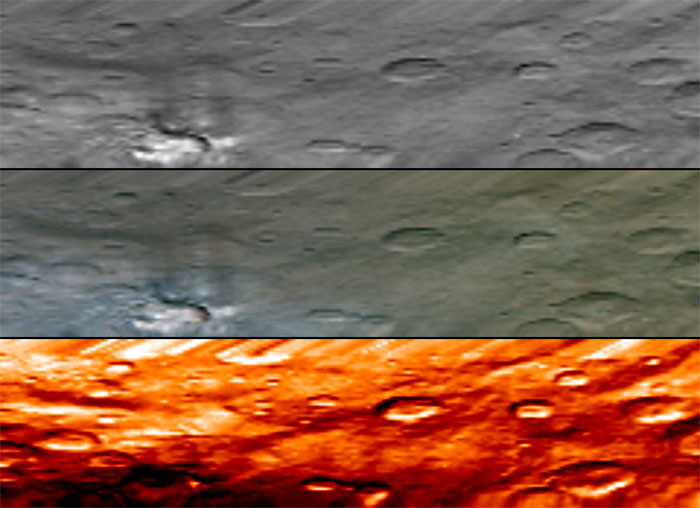
This image, from Dawn's visible and infrared mapping spectrometer (VIR), highlights a bright region on Ceres known as Haulani, named after the Hawaiian plant goddess.
Quelle: NASA
.
Update: 29.07.2015
.
Fruchtbarkeitsgöttinnen auf Zwergplanet Ceres
Tamayie, der polynesische Gott der Kokosnussbäume, hat es nicht geschafft, der mexikanische Gott Nanahuatl auch nicht. Aus rund 150 Fruchtbarkeitsgöttern und -göttinnen haben Wissenschaftler des Deutschen Zentrums für Luft- und Raumfahrt (DLR) für das Team der NASA-Mission Dawn 17 Namen für die prominentesten Krater auf Ceres herausgepickt und der International Astronomical Union (IAU) vorgeschlagen - denn der Zwergplanet ist nach der römischen Göttin des Ackerbaus benannt. Nun bevölkern Götter von fünf Kontinenten von der hawaiianischen Haulani über die römische Landwirtschaftsgottheit Occator bis hin zu zur deutschen Göttin Gaue die abwechslungsreiche Oberfläche. "Zwischen dem höchsten Berg und dem tiefsten Kraterboden liegen rund 15 Kilometer - das entspricht fast dem Relief der Erde zwischen Marianengraben und Mount Everest", erläutert Prof. Ralf Jaumann, Planetenforscher am Deutschen Zentrum für Luft- und Raumfahrt (DLR) und Mitglied des Dawn-Teams. Allerdings ist die Erde auch um das Dreizehnfache größer als Ceres. "In der Kruste von Ceres muss also eine enorme Dynamik stecken, die eine solche Topographie auftürmt."
Krater von tief bis flach
Vor allem die unterschiedlichen Kratertiefen in Relation zum jeweiligen Kraterdurchmesser sind für die Planetenforscher spannend: "Die Einschlagskrater Dantu und Ezinu sind extrem tief, größere Krater wie Kerwan und Yalode sind deutlich flacher", sagt Prof. Ralf Jaumann vom DLR-Institut für Planetenforschung. "Das weist darauf hin, dass das Eis mit Kratergröße und -alter mobiler wird und der Krater dadurch an Tiefe verliert." Dantu, benannt nach einem ghanaischen Erntegott, hat einen Durchmesser von etwa 120 Kilometern und ist fünf Kilometer tief. Die Abmessungen von Ezinu - der Krater hat seinen Namen von der sumerischen Göttin des Korns - sind vergleichbar. Damit sind diese beiden nur halb so groß wie der deutlich flachere Kerwan, benannt nach einem Hopi-Geist des Mais, und Krater Yalode, einer westafrikanischen Dahomey-Göttin. "Die Frage ist: Wie groß muss ein Krater sein, damit die durch den Einschlag erzeugte Spannung in der Kruste groß genug ist, um mittels Bewegung des Eises die Delle auszugleichen, was dann zu einer Hebung des Kraterbodens und zur Abflachung der Kraterränder führt - und wie lange dauert das?"
Namen für die Prominenten
Mit den 17 Fruchtbarkeitsgöttern und -göttinnen wurden in einem ersten Schritt nur die auffälligsten, prominentesten Krater mit Namen versehen. Damit erhalten auch die 15 so genannten Quadrangel (Abschnitte), in die die Oberfläche von Ceres aufgeteilt wurde, ihren Namen. Zwei dieser Regionen werden von DLR-Planetenforschern geologisch kartiert: Dies sind die Gebiete um Krater Sintana sowie Krater Haulani, indem sich einige der rätselhaften weißen Flecken des Zwergplaneten befinden. Haulani hat einen Durchmesser von etwa 30 Kilometern und - das haben Messungen mit Dawns Spektrometer ergeben - scheint kälter als das umliegende Gelände zu sein.
Der auffälligste Krater auf Ceres erhielt den Namen der römischen Gottheit Occator. Im Inneren des 90-Kilometer-Kraters liegen die hellsten Flecken, die man auf Fotos von Zwergplanet Ceres besonders gut erkennt. Krater Urvara, benannt nach der indischen und iranischen Gottheit der Pflanzen und Felder, ist besonders auffällig durch seinen drei Kilometer hohen Berg in der Mitte des 160 Kilometer breiten Einschlagbeckens. Auch der Krater auf dem nullten Längengrad, den die Wissenschaftler des Dawn-Teams nun festgelegt haben, erhielt einen Namen: Er wurde nach Kait, der hethitischen Göttin des Korns, benannt.
In der Warteschlange für den nächsten Krater
Doch auch die Götter und Göttinnen, die bisher noch nicht zum Zuge kamen, könnten noch an die Reihe kommen: "Auch die übrigen Krater auf Ceres werden noch benannt", erläutert Dr. Thomas Roatsch vom DLR-Institut für Planetenforschung. "Bei Saturn-Mond Enceladus wurden etwa 75 Krater benannt - und er ist nur halb so groß wie Zwergplanet Ceres." Es wird also noch kreative Arbeit auf das Dawn-Team zukommen, damit letztendlich alle wichtigen Strukturen auf Ceres einen Namen erhalten. Aussprechbar müssen sie sein - "das ist zum Beispiel bei polynesischen Göttern nicht einfach" - und die Fruchtbarkeitskultur der gesamten Welt abbilden.
Flug zum nächsten Orbit
In der Zwischenzeit senkt sich Raumsonde Dawn immer tiefer hinunter zur Oberfläche von Zwergplanet Ceres, um im August den nächsten Orbit zu erreichen. Dann wird sie aus nur noch 1470 Kilometern Entfernung auf Ceres blicken und ist damit drei Mal dichter dran als in seinem letzten Orbit. Während dieses Fluges wird die Kamera an Bord der Sonde keine Bilder aufnehmen können, da die Ionentriebwerke von Dawn in Betrieb sind. Selbst wenn Ceres weniger als halb so groß ist wie Zwergplanet Pluto, der von Sonde New Horizons im Juli 2015 im Vorbeiflug abgelichtet wurde - mit seinem Durchmesser von fast 1000 Kilometern ist er das größte Objekt im Asteroidengürtel zwischen Mars und Jupiter.
Die Mission
Die Mission DAWN wird vom Jet Propulsion Laboratory (JPL) der amerikanischen Weltraumbehörde NASA geleitet. JPL ist eine Abteilung des California Institute of Technology in Pasadena. Die University of California in Los Angeles ist für den wissenschaftlichen Teil der Mission verantwortlich. Das Kamerasystem an Bord der Raumsonde wurde unter Leitung des Max-Planck-Instituts für Sonnensystemforschung in Göttingen in Zusammenarbeit mit dem Institut für Planetenforschung des Deutschen Zentrums für Luft- und Raumfahrt (DLR) in Berlin und dem Institut für Datentechnik und Kommunikationsnetze in Braunschweig entwickelt und gebaut. Das Kamera-Projekt wird finanziell von der Max-Planck-Gesellschaft, dem DLR und NASA/JPL unterstützt.
Quelle: DLR
-
Update: 6.08.2015
.
Kreuzfahrt über Ceres in neuen Video
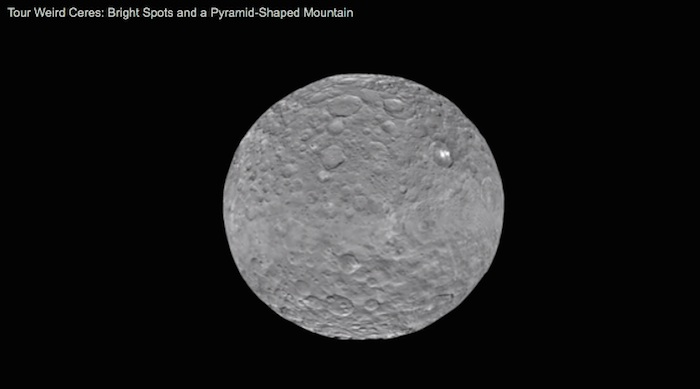
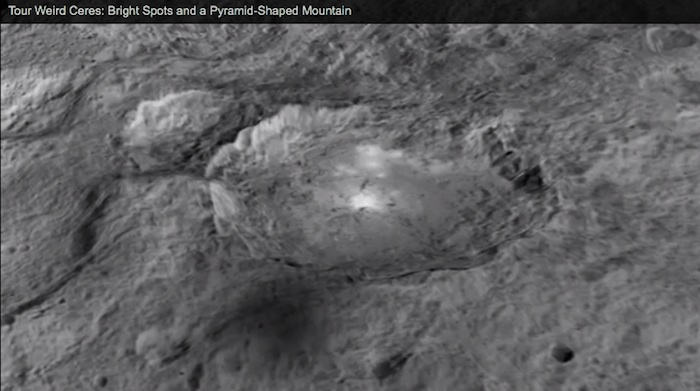
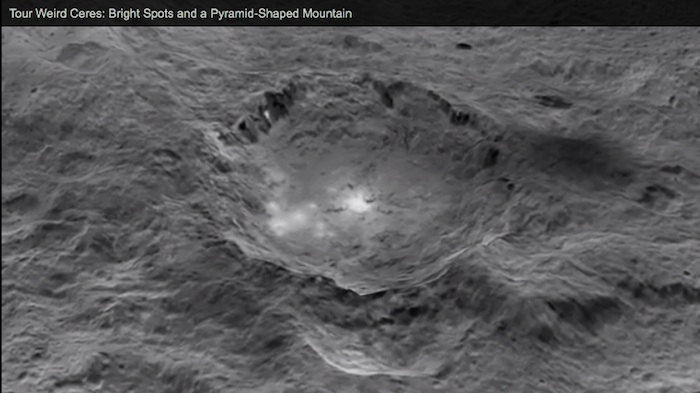
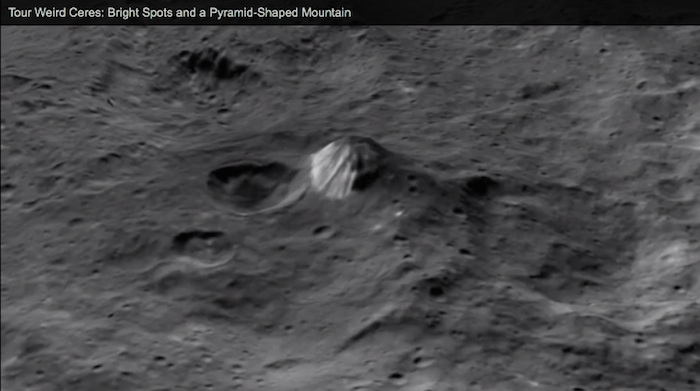
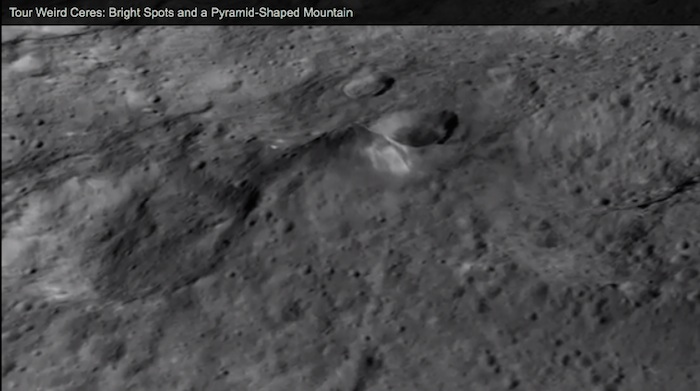
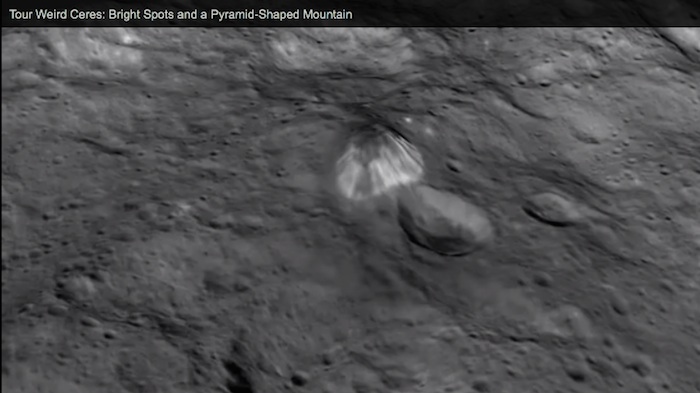
Striking 3-D detail highlights a towering mountain, the brightest spots and other features on dwarf planet Ceres in a new video from NASA's Dawn mission.
A prominent mountain with bright streaks on its steep slopes is especially fascinating to scientists. The peak's shape has been likened to a cone or a pyramid. It appears to be about 4 miles (6 kilometers) high, with respect to the surface around it, according to the latest estimates. This means the mountain has about the same elevation as Mount McKinley in Denali National Park, Alaska, the highest point in North America.
"This mountain is among the tallest features we've seen on Ceres to date," said Dawn science team member Paul Schenk, a geologist at the Lunar and Planetary Institute, Houston. "It's unusual that it's not associated with a crater. Why is it sitting in the middle of nowhere? We don't know yet, but we may find out with closer observations."
Also puzzling is the famous Occator (oh-KAH-tor) crater, home to Ceres' brightest spots. A new animation simulates the experience of a close flyover of this area. The crater takes its name from the Roman agriculture deity of harrowing, a method of pulverizing and smoothing soil.
In examining the way Occator's bright spots reflect light at different wavelengths, the Dawn science team has not found evidence that is consistent with ice. The spots' albedo - a measure of the amount of light reflected - is also lower than predictions for concentrations of ice at the surface.
"The science team is continuing to evaluate the data and discuss theories about these bright spots at Occator," said Chris Russell, Dawn's principal investigator at the University of California, Los Angeles. "We are now comparing the spots with the reflective properties of salt, but we are still puzzled by their source. We look forward to new, higher-resolution data from the mission's next orbital phase."
An animation of Ceres' overall geography, also available in 3-D, shows these features in context. Occator lies in the northern hemisphere, whereas the tall mountain is farther to the southeast (11 degrees south, 316 degrees east).
"There are many other features that we are interested in studying further," said Dawn science team member David O'Brien, with the Planetary Science Institute, Tucson, Arizona. "These include a pair of large impact basins called Urvara and Yalode in the southern hemisphere, which have numerous cracks extending away from them, and the large impact basin Kerwan, whose center is just south of the equator."
Ceres is the largest object in the main asteroid belt between Mars and Jupiter. Thanks to data acquired by Dawn since the spacecraft arrived in orbit at Ceres, scientists have revised their original estimate of Ceres' average diameter to 584 miles (940 kilometers). The previous estimate was 590 miles (950 kilometers).
Dawn will resume its observations of Ceres in mid-August from an altitude of 900 miles (less than 1,500 kilometers), or three times closer to Ceres than its previous orbit.
On March 6, 2015, Dawn made history as the first mission to reach a dwarf planet, and the first to orbit two distinct extraterrestrial targets. It conducted extensive observations of Vesta in 2011-2012.
.
Occator Crater: Enhanced View
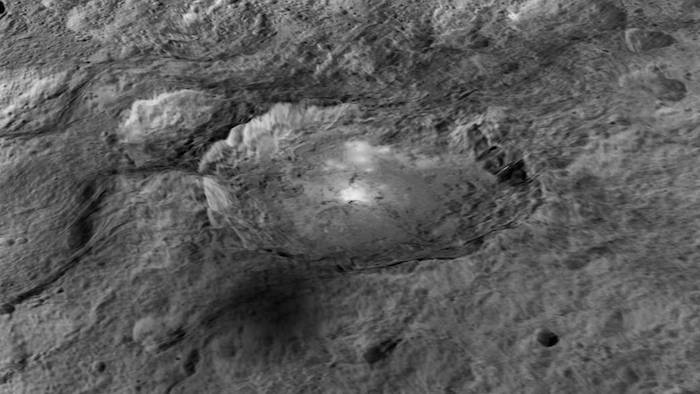
The intriguing brightest spots on Ceres lie in a crater named Occator, which is about 60 miles (90 kilometers) across and 2 miles (4 kilometers) deep.
This image comes from an animation, shown in PIA19619, generated using data from NASA's Dawn spacecraft. Vertical relief has been exaggerated by a factor of five. Exaggerating the relief helps scientists understand and visualize the topography much more easily, and highlights features that are sometimes subtle.
Quelle: NASA
4826 Views
